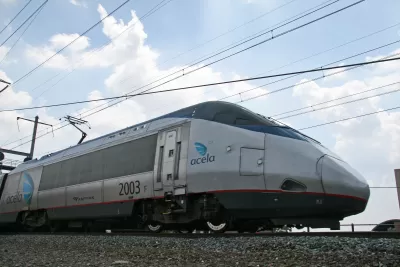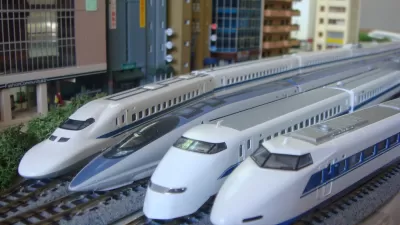Washington State released a report detailing the business case for connecting Seattle to Portland and Vancouver by high-speed rail.

The state of Washington released a report on economic impacts of a proposed high-speed rail (HSR) line connecting Vancouver, Seattle, and Portland. The report estimated that the line could bring 160,000 jobs to the Cascadia region and more than 350 billion new dollars in economic activity. "Drastically cutting travel time between the cities would also have the knock-on effect of drawing more companies to the region, which the report from the Washington State Department of Transportation argues would generate hundreds of billions of dollars in economic growth," Tyler Orton writes for Business in Vancouver. The new service could also curb emissions if it could tempt car and air commuters to use the train. The report estimates the project would eliminate 6 million tons of carbon emissions.
The planned train would travel at just under 200 miles per hour and be faster than any train service currently operating in the United States. Still, the Cascadia HSR is in the early planning phase. The proposed train does not currently have a route, and past attempts at HSR in the United States have failed to reach the speeds initially touted by boosters.
Even so, the report funded by the governments of British Colombia, Washington, Oregon, and the Microsoft Company does achieve a positive effect for the project. In 2017, the cost of the project was estimated to fall between $24 billion and 42 billion. The report says that estimate is still feasible.
FULL STORY: Vancouver-Seattle-Portland high-speed rail zips closer to reality with new business case

Study: Maui’s Plan to Convert Vacation Rentals to Long-Term Housing Could Cause Nearly $1 Billion Economic Loss
The plan would reduce visitor accommodation by 25,% resulting in 1,900 jobs lost.

North Texas Transit Leaders Tout Benefits of TOD for Growing Region
At a summit focused on transit-oriented development, policymakers discussed how North Texas’ expanded light rail system can serve as a tool for economic growth.

Using Old Oil and Gas Wells for Green Energy Storage
Penn State researchers have found that repurposing abandoned oil and gas wells for geothermal-assisted compressed-air energy storage can boost efficiency, reduce environmental risks, and support clean energy and job transitions.

Private Donations Propel Early Restoration of Palisades Playground
Los Angeles has secured over $1.3 million in private funding to restore the Pacific Palisades playground months ahead of schedule, creating a modern, accessible space that supports community healing after recent wildfires.

From Blight to Benefit: Early Results From California’s Equitable Cleanup Program
The Equitable Community Revitalization Grant (ECRG) program is reshaping brownfield redevelopment by prioritizing projects in low-income and environmental justice communities, emphasizing equity, transparency, and community benefits.

Planting Relief: Tackling Las Vegas Heat One Tree at a Time
Nevada Plants, a Las Vegas-based nonprofit, is combating the city’s extreme urban heat by giving away trees to residents in underserved neighborhoods, promoting shade, sustainability, and community health.
Urban Design for Planners 1: Software Tools
This six-course series explores essential urban design concepts using open source software and equips planners with the tools they need to participate fully in the urban design process.
Planning for Universal Design
Learn the tools for implementing Universal Design in planning regulations.
Ascent Environmental
Borough of Carlisle
Institute for Housing and Urban Development Studies (IHS)
City of Grandview
Harvard GSD Executive Education
Toledo-Lucas County Plan Commissions
Salt Lake City
NYU Wagner Graduate School of Public Service





























